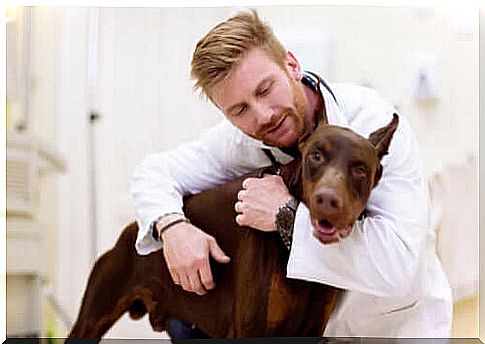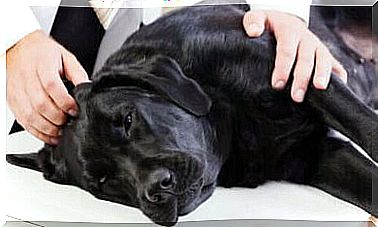Stomach Pain In Dogs: Causes And Main Symptoms

Stomach pain in dogs can panic their owners until they can figure out what’s going on. It’s important to keep in mind that abdominal pain is a very common medical problem that can come along with stomach bloating.
We can identify it through some signs. Generally, a typical sign of pain is shallow breathing, which can be accompanied by lack of energy and lack of appetite. In this article, we are going to talk in detail about the main symptoms of this condition.
What Defines Stomach Pain in Dogs?
Stomach pain is commonly referred to as a whole spectrum of conditions that cause abdominal pain. Medically, repeated episodes of discomfort in a dog’s abdominal area are known as an acute abdomen.
In general, there are two types of acute abdomen: infectious or non-infectious. Within these groups, there are several types of abdominal pain: digestive, metabolic, musculoskeletal, peritoneal cavity, reproductive and urinary systems.
What to do during an episode of stomach pain in dogs?
While abdominal pain in dogs can be difficult to recognize, you should always be on the lookout for changes in your pet’s behavior. Take your dog to see the vet whenever you suspect he is acting differently.
In the case of abdominal pain, the underlying pathology must be treated without delay, as there may be a risk of diseases, such as obstructions or tumors, for example.

Main symptoms
As an owner who watches your dog on a daily basis, you will be able to identify changes in his behavior that indicate the presence of pain. Among the list of possible warning signs, we can include:
- Swollen and sensitive abdomen.
- Vomiting.
- Loss of appetite.
- Whimper.
- Difficult breathing or abnormal breathing patterns.
- Adopt the following posture change: lift your hips and bring your shoulders and forelegs closer to the floor.
- Difficulty getting up when lying down or restless because the dog cannot find a comfortable position.
- Diarrhea, bloody stools or mucus, dehydration.
- Depression or lack of energy.
- Fever.
Causes of Abdominal Pain in Dogs
There are a number of reasons why your dog may be suffering from an acute abdomen. Fundamentally, abdominal pain in dogs is divided into two types: infectious or non-infectious. Within these two categories, there are several types of abdominal pain:
- Metabolic, such as kidney failure, liver disease, malabsorption, ischemia (inadequate blood supply to an organ or part of the body), cancer.
- Peritoneal cavity, such as urinary trauma, urethral obstruction, cystitis, peritonitis (inflammation of the abdominal lining).
- Digestive, such as gastric torsion, pancreatitis, gastritis, gastrointestinal ulcer, intestinal inflammation, constipation or gastrointestinal obstruction.
- Reproductive, like prostatitis.
- Musculoskeletal, such as trauma to the abdominal muscle.
- Neurological.
- Bacterial, parasitic and viral infections , such as canine parvovirus or leptospirosis.

veterinary consultation
An important part of the diagnosis is the interview. It is important to be prepared to report which signs have manifested. Tell me about the pet’s recent meals and if you have introduced any new foods.
You should also let them know if you have visited new places or if your dog may have been exposed to toxins or chemicals. Likewise, it is helpful to report whether the dog has suffered trauma or recent injury.
After that, your veterinarian may decide to do blood and urine tests on your dog. He will also have a physical examination, looking for evidence of trauma, such as bruises or blood. In addition, he will also examine your lungs and heart and feel your abdomen.
If necessary, the veterinarian can perform an x-ray, a fluoroscopy and a cytology to better diagnose the possible causes. Treatment will depend on the causes of pain.









